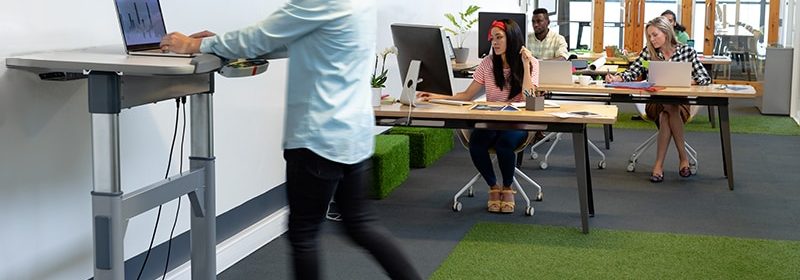individually packaged ibuprofen

Breaking up sedentary time behind a desk by taking a 5-minute stroll every half hour was the optimal break from being seated to improve cardiometabolic and mental health, results of a small cross-over study show.
“We set out to figure out what’s the bare minimum someone has to do in terms of movement” to counteract the harmful effects of sitting too much, senior author Keith M. Diaz, PhD, told Medscape Medical News.
The researchers enrolled 11 adults in their 40s, 50s, and 60s and compared health measures while sitting 8 hours without breaks (control) vs sitting 8 hours and taking a 1-minute or 5-minute walking break every half hour, or every hour.
When the participants took a 5-minute light walk after every half hour of sitting, the blood glucose spike after eating was reduced by 58% compared with sitting all day, flexeril causing nightmares which is “comparable to the reduction you would see if someone had diabetes and was using insulin injections or diabetes medications to control their blood sugar,” noted Diaz, from the Center for Behavioral Cardiovascular Health, Columbia University Medical Center, New York City.
The largest reductions in systolic blood pressure were observed when the walking break was 1 minute every 60 minutes (-5.2 mm Hg) and 5 minutes every 30 minutes (-4.3 mm Hg). A 4- to 5-mm Hg reduction is what “you’d expect to see if you had someone exercise daily for 6 months, he noted.
The take-away message is that “if you have a job or a lifestyle where you have to sit for long periods of time, we suggest taking a 5-minute walking break every half hour. That’s one behavior change that could reduce your health risks from sitting.”
“Higher frequency and longer duration breaks (every 30 min for 5 min) should be considered when targeting [blood glucose], while lower doses may be sufficient for [blood pressure] lowering,” the researchers conclude.
The science shows us that it’s not as simple as just meeting suggested exercise for good health, Diaz added. “You can’t just exercise for 30 minutes every morning and go sit the rest of your day,” he stressed. “Your body needs perpetual regular movement. That’s the key here. Our body needs regular ‘activity snacks’ throughout the day to operate well or optimally.”
The study by Andrea T. Duran, also of Columbia University Medical Center, and colleagues was published online today in Medicine & Science in Sports and Exercise.
Study Offers Guidance to Employers to Make Healthier Workplaces
“I think ultimately we can get employers to recognize that prolonged sitting is an occupational hazard that we need to address, and it’s gotten worse since COVID-19,” said Diaz.
According to him, this study “offers clear guidance to employers as to how they could make their workplaces healthier, and we know that healthy employees are more efficient and productive employees.”
It showed that “walks to break up your sitting put you in a better mood, you feel more energized. In the workplace, it may seem counterintuitive, but taking regular breaks can actually help you be more productive than working without stopping.”
Optimal Duration and Frequency of Breaks From Sitting
The researchers aimed to determine the optimal duration and frequency of low-intensity walking breaks during a simulated 8-hour, sedentary workday.
They enrolled 6 men and 5 women aged 45 and older who were sedentary for at least 8 hours a day, based on readings from an accelerometer worn over 7 days before the trial started, between November 2018 and March 2020.
The men and women had a mean age of 57 and were diverse in ethnicity (White, Black, Hispanic, other) and weight (normal weight, overweight, obesity).
Most (91%) had normal glucose. Close to half (46%) had normal blood pressure (< 120/80 mm Hg) and 18% were hypertensive (> 140/90 mm Hg or on antihypertensive medication).
The participants completed the five 8-hour trial conditions, in random order, on separate days with washout periods between conditions.
While they were sedentary, participants could read or use their phone or a computer. The walking breaks consisted of walking on a treadmill at 2 miles per hour (0% incline).
The participants received a standard breakfast, followed by a standard lunch 4 hours later. They wore a continuous glucose monitor (CGM), and glucose was recorded every 15 minutes.
At baseline and every hour prior to scheduled activity breaks, the researchers measured the participants’ blood pressure, and the participants reported their fatigue level on a visual analog scale.
At baseline, 4 hours, and 8 hours, the participants answered a “Profile of Mood States” questionnaire about mood (anger, confusion, depression, fatigue, tension, and vigor) and did a “Symbol Digit Modalities” test that measures cognition.
Compared to the sedentary condition with no breaks (control), glucose spikes after eating were only significantly attenuated during the sedentary condition that included a 5-minute walking break every 30 minutes.
During the four conditions with walking breaks, the participants had significant decreases in systolic blood pressure from baseline compared to the control condition (P < .05).
Most participants (≥ 80%) reported that they would be willing to take 1-minute or 5-minutes breaks from being sedentary, every half hour or 1 hour, over the long term.
Taking 5-minute breaks after sitting for 30 minutes or 60 minutes was associated with significant improvements in fatigue and mood (notably vigor); the improvements were less robust with 1-minute breaks after sitting this long.
There were no significant improvements in cognition scores from taking these breaks from sitting.
Med Sci Sports Exerc. Published online January 12, 2023. Abstract
For more diabetes and endocrinology news, follow us on Twitter and on Facebook
Source: Read Full Article